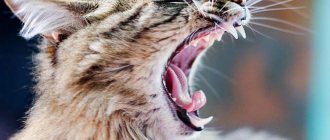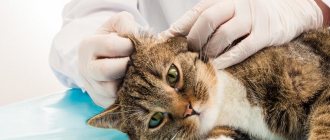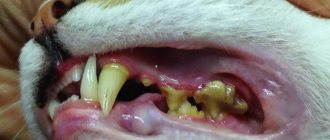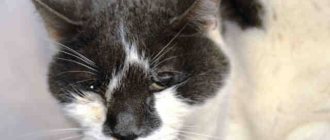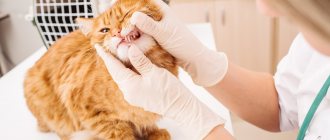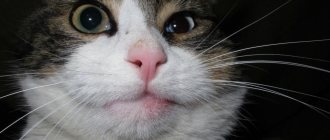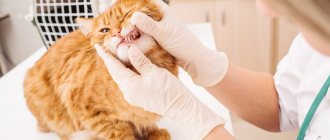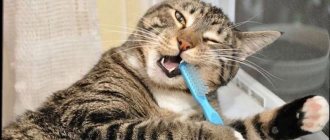What to do if your cat has yellow teeth
Pets also need hygiene, just like people. This is especially true for oral care. Owners often discover that their cat has yellow teeth. Why does this happen and what to do about it?
The first reasons why a kitten's teeth turn yellow may be plaque, tartar or caries. Plaque occurs due to the fact that food remains on the teeth, which are considered half-life products. As a result, a favorable environment for active reproduction appears.
Also, the following phenomena can be attributed to the causes of yellow teeth in cats:
:
Domestic cats develop plaque on their teeth much more often than indoor cats, who chew grass and gnaw bones, which cleans their jaws. If the pet is under the full care of a person. Then the responsibility for dental health is shifted to the owner.
How to deal with the problem?
If the owner promptly pays attention to the appearance of plaque in the cat and takes all measures to eliminate it, then it will be possible to prevent the development of many oral pathologies.
Tartar is a hard deposit on the surface of fangs and other teeth, so it cannot be removed simply with a brush. Veterinarians use special instruments or the ultrasound method for this.
If the pathology is not advanced, then a gel that is designed to dissolve such deposits on the teeth can help. If tartar has affected the gums, then manipulations are carried out under anesthesia.
You need to understand well that the development of many dental pathologies can be avoided by taking preventive measures and immediately contacting a specialist if changes in tooth enamel occur.
Newborn kittens require special attention.
Injuries as a consequence of communication with.
Along with medicinal methods of struggle.
Change in cat stool - .
Add a comment Cancel reply
- Natalya on How many days does a cat walk?
- Alexander on How to understand that a cat is dying
- Ekaterina on Why cats become aggressive after sterilization
- Elena on Laparoscopic sterilization of cats
- Elena on the post The cat is drooling from its mouth
https://koshkamurka.ru/5443-zheltye-zuby-u-koshki.html
Treatment
Therapy involves removing the dental growth, or tooth, as well as eliminating complications. All procedures are painful, so the fellinologist must be prepared to perform the operation under anesthesia. Dental stones are destroyed using ultrasound or a dental instrument. The gums and teeth are carefully cleaned so that the remaining particles do not become centers of re-crystallization.
At the initial stage of the disease, teeth are cleaned without anesthesia, gradually using analgesics. The surgical operation ends with polishing the tooth. The mouth cavity is treated with an antiseptic.
At the discretion of the veterinarian, steroidal antiphlogistants, painkillers Dentavedin, Zubastik or Metrogyl-Denta are used. If treatment does not lead to recovery, the dent is removed.
The cat has toothache: dental problems and diseases in cats. How to treat a cat's teeth
Do cats have teeth pain?
Dental problems in cats: symptoms
If a cat has toothache, he will certainly let you know about it.
Dental diseases in cats are manifested by the following symptoms:
- the cat rubs its cheek with its paw or rubs against objects;
- gums become inflamed and swollen;
- Bad breath may appear;
- partial or complete loss of appetite;
- possible darkening of teeth;
- the cat is acting restless;
- increased salivation.
Dental diseases in cats
What types of dental diseases do cats have: caries, osteomyelitis, pulpitis, periodontal disease, as well as stones on the teeth of cats. Only a veterinarian can make a correct diagnosis.
The cat has plaque on his teeth
Plaque on a cat’s teeth appears when the pet is 1.5 years old. As a rule, when a cat has a cat, this does not cause any inconvenience to the animal, but if the cat still shows anxiety, you just need to brush his teeth, it is enough to do this once a week.
The cat has yellow teeth
Stones on cats' teeth
The cat's teeth are rotting
Cat has black teeth
Black teeth in a cat most often indicate the presence of caries or pulpitis, which can be treated by simply installing a filling. If, in addition to a black tooth, the cat has additional symptoms, a veterinary dentist will make an accurate diagnosis.
Tooth inflammation in cats
To avoid complications and further inflammation, you need to brush your teeth and remove tartar.
How to treat a cat's teeth?
A cat's teeth must be treated under general anesthesia.
(1 star #8212; didn't like it, 5 stars #8212; liked it)
https://elite-british.by/boljat-zuby-u-koshki/
Even if the only things your cat hunts for are chicken-flavored food and toy mice, she still needs clean, sharp teeth and healthy gums. Damage to the tongue, teeth, palate and gums can lead to many health problems in cats, but this can be prevented with regular home checks and a good old-fashioned toothbrush.
Here are ten steps to healthy cat teeth:
1. Breath test: “breathe, I’ll sniff.” Of course, a cat's mouth shouldn't smell like roses, but the smell shouldn't be unpleasant or disgusting. If there is an abnormally strong breath coming from your kitten's mouth, he may have problems with his digestion or gums (for example), and should be taken to the veterinarian.
2. Inspection of the lips: pull the cat's head towards you and gently move her lips away, look at the gums. The gums should be firm and pink, not white or red, and there should be no signs of swelling. The teeth should be clean and free of brownish tartar, and there should be no broken or missing teeth.
3. Closer Look: Check for the following signs that could indicate dental health problems in your cat:
- Dark red lines along the gums;
- Red and swollen gums;
- Sores on the gums or tongue;
- Lost teeth;
- Pus;
- Difficulty chewing food;
- Strong;
- The cat scratches and scratches the mouth area vigorously.
4. Dangerous swelling: If you notice any signs of gum inflammation, be sure to take your cat to the vet for a checkup. If gum disease is left untreated, it can lead to tooth loss and eating difficulties. Gum inflammation can also indicate internal problems such as or.
5. The Lowdown on Tooth Decay: Bacteria and plaque-forming foods can accumulate on your cat's teeth. They can harden and turn into tartar. Tartar can cause gum inflammation and tooth loss. Solution? Of course, this means regular brushing of your teeth.
6. Brushing your cat's teeth: All you need to clean your cat's teeth are cotton swabs, a small toothbrush, and a tube of toothpaste designed specifically for cats (available at any pet store). You can also use salt and water. Never use toothpaste intended for humans, as the ingredients may be harmful and even poisonous to your cat!
7. Sparkling and Pearly Whites: Clean your cat's teeth at home by following these simple steps:
- Your cat needs to get used to the toothbrush first. Start by gently massaging her gums with your fingers and touching them with cotton balls.
- After a few sessions, place some cat toothpaste on her lips so she can taste the paste.
- Next, try using a toothbrush designed specifically for cats that is smaller than human toothbrushes and has soft bristles. There are also toothbrushes on sale that you can put on your finger, which also allow you to give your cat's gums a good massage.
- Finally, apply toothpaste to your teeth for a gentle brushing.
- It's a good idea to take your cat to the vet for a check-up in advance to find out if your cat has gum disease. Many cats have mild gingivitis, and brushing their teeth and gums too hard can harm them.
8. Chew Toys: Chew toys will help satisfy your cat's natural urge to chew, making her teeth stronger. Chew toys can also help your cat clean his teeth, massage his gums, and gently scrape away tartar.
9. Diet for healthy teeth: If your cat has dental problems, contact your veterinarian to recommend a special food that will help keep your cat's teeth healthy and remove plaque.
10. Knowledge of Oral Diseases: If your cat is suffering from any of the following symptoms, contact your veterinarian immediately:
- : This is an inflammation of the gums that occurs mainly in older cats. It may start as a dark red line bordering the teeth. If the condition is not treated, the gums may become inflamed and ulcerate. This condition may be a sign of feline immunodeficiency virus or another infection.
- Periodontitis: If gingivitis affects the socket of a tooth, the tooth may fall out and an abscess may form in its place.
- : This is an inflammation of the mucous membrane of the mouth. May be the result of a foreign body in the mouth, a viral disease, or dental problems. In this case, the cat experiences difficulty feeding, and the oral mucosa becomes red.
- Ulcer: A slowly expanding sore, wound, ulcer, or swelling on the upper lip.
- Salivary cyst: If the salivary glands or ducts that carry saliva into the mouth are blocked, cysts can form under the tongue.
- Mouth ulcers: Ulcers on a cat's tongue and gums are sometimes caused by respiratory or kidney problems.
A domestic furry pet, no matter how affectionate and playful it may be, is still a predator with well-developed teeth that help the animal both in hunting and in capturing food. It is important for the owner to ensure that the adult cat’s teeth are in healthy condition; the well-being of the body as a whole depends on this. Malocclusion, caries, and tartar lead to poor appetite and exhaustion.
The condition of the teeth can also determine such an important parameter for the owner as the age of the animal.
Read in this article
24-hour veterinary clinics Svoi Doctor
Student work: Bisingalieva D.Kh. 5th year FVM
Tartar (Calculus dentalis) is calcareous deposits on teeth, usually a mixture of phosphate and calcium carbonate with a minor content of organic matter and various microorganisms. Dark brown or yellowish in color. This color is given to tartar by food debris, bacteria, phosphorus salts, iron salts and other microelements.
Causes
Symptoms
- unpleasant odor;
- salivation;
- difficulty eating;
- jaw clattering;
- temperature;
- purulent nasal discharge;
- vomit.
In dogs, these problems are most often found in most small decorative breeds, such as poodles, Yorkshire terriers, cocker spaniels, dachshunds, toy terriers, lapdogs, etc.
In cats, this disease is more common in Persians, British, and Scottish Folds.
First, a soft plaque forms, consisting of microflora, polysaccharides, and remains of soft food.
Initially, tartar is deposited in those areas of the teeth where sufficient self-cleaning does not occur when chewing food, in places where microbes accumulate, therefore, in veterinary practice, tartar is especially common on the outer surface of the canines, posterior premolars and on the first molars of the upper jaw, causing only retraction and inflammation of the gums, but also ulcerative inflammation of the cheek from the side of the tooth.
The substrates of tartar are food, microbial and tissue detritus of the oral cavity, saliva, and food residues. Plaque is fixed on teeth using the adhesion mechanism, physicochemical processes, and during colonization of the oral cavity by bacteria.
Tartar is protected by a film consisting of glycoproteins, which are not affected by enzymes of saliva and the oral cavity, which allows maintaining its autonomy and contents. The formation of acidic products in soft plaque has a pathogenic effect on teeth and periodontium.
The allergenic, stimulating inflammatory reaction effect of soft plaque on periodontal tissue is also great. Soft plaque can be removed by brushing your teeth. If the soft plaque is not eliminated, then tartar will form over time.
Exists :
1) Supragingival calculus is formed by mineralization of soft plaque; Supragingival is formed on the free surface of the tooth, has a yellow or brown color, a rough surface, which promotes the deposition of new layers and increases the size of the stone.
2) Subgingival – under the marginal gum (it is formed from blood plasma proteins or gingival fluid). Subgingival is located on the root of the tooth, dark green in color, much harder than supragingival. Its formation is associated with biochemical abnormalities in the blood serum, while supragingival depends on the composition of saliva.
Treatment
- Mechanical removal of large stones.
- Ultrasonic cleaning.
- Grinding and polishing of teeth with special pastes.
Treatment is aimed at removing plaque and stones, necessarily removing non-viable teeth, antibacterial therapy, therapy aimed at improving the condition of the gums and oral mucosa, if necessary, detoxification therapy and treatment of concomitant diseases.
Therapeutic treatment consists of prescribing antiseptic and astringent agents. With the development of stomatitis, antibiotic therapy, immunostimulation and vitamin therapy are carried out. An appropriate diet must be prescribed (Hill's Prescription Diet Canine t/d and t/d Mini.).
In general, dental plaque removal is painless and is performed without local anesthesia. In some cases, if the dog is aggressive and excitable, anesthesia and/or local anesthesia is given.
As a result of the impact of dental plaque and tartar on the oral mucosa, stomatitis almost always develops. And even after removing tartar in the cervical area, hypertrophy of the interdental papilla and bleeding of the gums are observed. Therapeutic treatment of stomatitis consists of local use of antiseptic and analgesic astringents (vagotil (1:1000), Trauma-gel).
With severe development of stomatitis, a course of treatment was prescribed with Travmatin injections and locally - turunda in the form of applications with Travma-gel.
During the traumatic process, Travmatin has analgesic, hemostatic, and anti-inflammatory effects. As a result of its use, regeneration processes proceed faster.
Complete and detailed removal of tartar can only be achieved using special dental equipment under general anesthesia. It should be noted that mechanical removal of large stones has only a superficial effect and has little effect on pathogenesis. Subgingival areas need to be cleaned!
Ultrasonic cleaning:
- Piezon Master 400 device.
-Ultradent
The device is designed to apply ultrasound to dental plaque in order to remove it. The presence of a variety of tips allows you to remove stone, plaque from the surface of the teeth and stone from the interdental spaces. After plaque or tartar is removed, the crown of the tooth is polished.
Removing tartar using ultrasound is safe for tooth enamel, and the presence of a variety of attachments allows you to achieve an excellent cosmetic effect
Prevention:
1. Refusal to use fine feed
2. Portioned feeding (only 2 times a day)
3. Using special cleansing seeds after meals
4. Use of specialized feeds, for example Hills Canine t/d
5. Active exercise, walks, etc.
6. Timely sanitation of the oral cavity and prevention of the appearance of dental plaques, as well as preventing their recurrence.
Prevention must be addressed from a very early age, because dental problems in older age will lead to diseases and disorders in other systems and organs.
An animal with bad teeth cannot chew food well enough, and it ends up in the stomach in large pieces and insufficiently processed by saliva. If this happens continuously over a long period of time, then digestive disorders can become irreversible.
In turn, due to disruption of the digestive process, the absorption of digested food is disrupted, and metabolic diseases arise.
With tartar deposits, bacterial contamination of the oral cavity increases many times over. With each sip, the animal receives more and more new portions of bacterial agents. Eventually, the body's immune system can't handle it. A huge amount of bacterial toxins and breakdown products are excreted by the kidneys, which can lead to chronic renal failure.
Also, a large amount of toxins and breakdown products are carried by the blood throughout the animal’s body and settle in places where there is already a predisposition or disease. As a result, treatment of diseases of internal organs must begin with sanitation of the oral cavity.
Source: https://www.svoydoctor.ru/spetsialistam/biblioteka/stati/article/zubnoj-kamen-u-koshek-i-sobak-lechenie-i-profilaktika.html
Determining age by teeth
Kittens are born toothless. The deciduous incisors begin to erupt first; this occurs at approximately 2–5 weeks of a baby’s life. At 3 weeks, baby fangs are already growing, this process lasts up to 8 weeks. 2 - 3 weeks after their appearance, the primary premolars begin to erupt. At the age of 3 - 6 months, kittens change their milk teeth to permanent ones. As a rule, by the age of one year a young animal has erupted 30 teeth: 16 on the upper jaw and 14 on the lower jaw.
Determining the approximate age of a pet by its teeth is not so difficult and even the owner can do it:
- If 30 snow-white teeth are found in the mouth without signs of pigmentation or abrasion, then we can confidently say that the animal is 1 year old.
- At the age of 1.5 years, yellowness appears.
- At 2 years of age, the middle incisors of the lower jaw begin to wear off, and a clearly visible yellow discoloration appears. At the same time, tartar formation may occur.
- At 3 years of age, wear of the central incisors located on the lower jaw is already noticeable.
- If, upon examination, the abrasion of the fangs is noticeably expressed, then this condition is typical for an animal 5 years old. At this age, a dark yellow plaque is clearly visible on all teeth.
- After 5 years of age, the chewing surface of the incisors is destroyed.
- Wearing of the upper and lower incisors can be seen in a cat at the age of 7 - 8 years.
- If not a single incisor is found in the animal’s mouth, then the animal is from 12 to 14 years old.
- After 14 - 15 years, fangs fall out. How many teeth a cat will have after 15 years depends largely on nutrition and proper hygienic care of the animal’s mouth.
The older the pet is, the more pronounced the yellow coating is. Tartar formation occurs already at the age of one and a half years and largely depends on the type of diet and proper dental care. Even a specialist often finds it difficult to determine the exact age of incisors and canines due to the fact that improper care or lack thereof leads to premature wear.
Cat's dental system
How many teeth a cat has is a question that interests many owners. Pets are born toothless. The first incisors are cut around the 2nd week of life. Then the canines and molars grow. They are cut from the pet until the end of the 1st month of life. In total, the kitten develops 26 teeth, of which 14 are on the upper jaw, and 12 on the lower jaw.
Milk teeth in cats, like in humans, are replaced by permanent teeth. This process begins at the age of 4 months. The change of teeth in cats is completed at 8 months. 4 additional teeth also grow, and there should be 30 in total (16 on the upper jaw and 14 on the lower jaw). The arrangement of a cat's teeth is quite simple. The dental system of an adult pet includes:
- incisors, located in the front and used to capture prey;
- fangs designed for tearing prey;
- premolars involved in chewing food;
- molars, which are also involved in grinding food.
An adult cat has a total of 30 teeth: 12 incisors, 4 canines and 14 premolars (8 on the upper jaw and 6 on the lower jaw). The change of teeth is completed at approximately eight months. The permanent teeth are very sharp and have a cutting surface. Incisors are needed to capture food and care for fur, fangs are a formidable weapon for hunting and protection from enemies, premolars crush large pieces of food.
If all of the permanent teeth have grown in after a year, the cat will be missing one or more teeth for the rest of its life. Oligodontia (congenital lack of teeth) is inherited, so such an animal must be removed from breeding. Depending on how many teeth are missing, the pet experiences a certain degree of discomfort when eating food.
Brushing and caring for your teeth
The owner of a furry beauty should pay attention not only to rational nutrition and hygiene procedures, but also to caring for the animal’s mouth. Healthy teeth facilitate proper gripping and chewing of large pieces of food and ensure normal digestion. The condition largely depends on proper and regular brushing, which prevents the formation of tartar.
Tartar is hardened remains of food and salts on the enamel. Deposits are localized at the root of the tooth. Bacteria lead to inflammation of the gum, it peels off and exposes the neck of the incisor or canine. The infection is accompanied by painful sensations and bad breath. The animal, experiencing discomfort when chewing food, loses appetite and loses weight. Tartar formation often leads to premature tooth loss.
The main reason for the development of deposits on the gums and teeth is the lack of solid food in the pet’s diet, which mechanically promotes cleansing. Regular cleaning also helps prevent development.
A pet should be accustomed to a procedure such as brushing its teeth from a young age. You can clean them for your cat with a finger wrapped in gauze, a children's toothbrush, or a special brush attachment for small animals. Preference should be given to a brush with soft or natural bristles.
For pets, special cleaning pastes are used, which can be purchased at a specialized pet store. Cat toothpastes are safe to use, clean teeth well, and have a taste and smell that is attractive to cats. Such pastes do not need to be washed off with water.
Your pet should be accustomed to the procedure gradually. At first, you can put a small amount of paste on the cheek so that the cat gets used to the taste of the cleaning product. The first manipulations may not last long, a few seconds. When the animal gets used to it, the duration of the procedure should be increased to 2 - 3 minutes. To brush its teeth correctly, the animal must be turned with its back to you. The movements should be clear: back and forth and up and down.
How many teeth an adult cat will have in old age depends on the regularity of hygienic cleaning. Daily cleaning of plaque will help maintain the health of your cat’s teeth for a long time and prolong the animal’s comfortable life.
To learn how to properly brush your pet's teeth, watch this video:
Symptoms of diseases
- - refusal of solid food, loss of appetite, difficulty chewing;
- - unpleasant odor from the mouth;
- - inflammation, redness and swelling of the gums;
- - flowing saliva;
- - darkening of teeth, their mobility.
Attention! Any changes in the pet's behavior should alert the owner and cause a visit to the veterinary clinic.
Causes of tooth loss
Often, the owner of a domestic cat finds a lost tooth near the food bowl or in another place in the apartment. There are several reasons why an animal loses its hunting tool and means of chewing.
Change of dairy
At a young age, a pet loses teeth due to the physiological change from milk teeth to molars. During this period, a small kitten has 26 teeth. And only by the age of one year will the molars grow and a complete “combat” set will appear.
As a rule, the stage of changing milk teeth to permanent ones occurs painlessly for the animal. However, the owner needs to periodically check the pet’s mouth and observe how the process occurs.
In some cases, when examining a kitten's oral cavity, redness of the gums and bad breath may be observed. Particular attention should be paid to the formation of a correct bite. Often, primary fangs do not fall out immediately, disrupting the structure and proper formation of neighbors. In this case, qualified assistance from a specialist is necessary.
During the period of teeth change, the animal may be depressed and refuse to eat. Often young kittens try to chew on foreign objects. In this case, the baby should purchase special toys at the pet store.
Toys for kittens and cats
Despite the physiological cause of tooth loss in young animals, your pet should be seen by a veterinarian. A professional examination of the mouth will prevent the development of malocclusion; if necessary, the doctor will remove the interfering primary premolar.
Pathologies
Often the cause of tooth loss in adult animals is dental problems such as tartar, oral dysbacteriosis, and caries. The development of pathology is caused by:
- malocclusion,
- unhealthy diet
- lack of hygiene procedures,
- genetic predisposition.
Often tooth loss occurs due to a lack of vitamins and minerals in the animal. Calcium and phosphorus deficiency can cause an adult cat to become toothless. Concomitant diseases also lead to premature loss: liver disease.
How many teeth a cat loses as an adult is influenced by the development of more complex pathologies, for example, periodontitis, pulpitis. As a result of these dental diseases, your pet may lose most of its teeth in a short period of time.
To prevent oral diseases that can lead to toothlessness, veterinary experts recommend:
- Brush your cat’s teeth daily with special toothpastes;
- Give calcium and phosphorus supplements regularly after consultation with your veterinarian;
- if you are prone to dental problems, transfer your pet to specially designed food to clean the surface of the teeth from plaque and tartar formation;
- periodically inspect the cat’s mouth yourself;
- Regularly visit a specialized clinic for a professional examination.
Most veterinarians believe that the pathological process in the cat’s oral cavity is triggered by pathogenic bacteria, which lead to the development of dysbacteriosis.
Age-related changes
The loss of the first incisors by a furry pet due to old age usually occurs after 7 - 8 years. Some animals begin to lose their incisors only at 14–15 years of age. The process is individual and depends on many factors: good nutrition, regular hygiene procedures, preventive examinations by a veterinarian, the presence of concomitant diseases and even lifestyle.
Often, the loss of fangs in adult cats occurs not from old age, but from street fights, falls from a height, or injuries.
Diagnostics
If you suspect such a problem, the animal should be shown to a specialist.
If you can tell from their behavior that your cat has a toothache, it is important to find out the root cause of the pathology and, if necessary, begin to treat the disease. To determine an accurate diagnosis, you need to visit a veterinarian. During the initial examination, the doctor examines the oral cavity and teeth, and asks the owner about the animal’s behavior. To determine the extent of the pathological process, radiography may be prescribed. To cure a disease, you need an integrated approach, so self-medication is contraindicated.
Is it scary that a cat has no teeth?
A feature of the digestive system of domestic cats is that there is no great need for thorough chewing of food. The canines and front incisors are necessary for the pet, as a predator, to capture and hold prey, tear it into pieces, and chew bones. Domestic cats that are fully maintained by their owner practically do not experience tooth loss.
The owner needs to pay attention to a cat that has lost its fangs and incisors, switching it to soft food. To improve digestion, a toothless pet should be given pureed food, minced through a meat grinder or crushed in a blender. Soft food is the optimal solution both for an adult animal that for some reason has lost teeth, and for an elderly cat that has lost its fangs and incisors due to age-related changes.
Prevention
Unfortunately, dental diseases are a common occurrence. In their natural environment, cats clean their teeth mechanically by eating raw meat and chewing cartilage. In addition, a domestic cat lives twice as long as a stray animal - the enamel wears off with age, stress on the teeth leads to mechanical damage, bacteria penetrate through the cracks, which in turn leads to caries and other problems. Many owners make the situation worse because they are simply too lazy to brush their pet’s teeth. To keep your teeth healthy for many years, you need to:
- regularly inspect the oral cavity, removing stuck pieces of food;
- consult a doctor if you notice even minor signs of gum or dental disease;
- feed the cat a balanced diet (if dry food is used, periodically add lines designed to prevent diseases of teeth and gums to the oral food menu).
Since not every owner is able to brush a pet’s teeth (some pets categorically refuse to tolerate a foreign object in their mouth), it is necessary to take the cat to the veterinarian at least once every six months to remove plaque and tartar.
If possible, you should brush your teeth once a week. To remove plaque, use a brush with soft bristles or a special finger attachment equipped with rubber teeth. Human toothpaste is not the best choice; it is wiser to purchase a special toothpaste or gel for pets. The cat is taught to brush its teeth gradually, first by just examining the oral cavity, then touching the teeth with your fingers, then letting the cat chew on a brush with paste applied to it (a paste with a meat aroma and taste that will not frighten the pet with a “chemical” smell is ideal). After cleaning, excess paste should be removed with a sterile gauze swab.
A domestic furry pet, no matter how affectionate and playful it may be, is still a predator with well-developed teeth that help the animal both in hunting and in capturing food. It is important for the owner to ensure that the adult cat’s teeth are in healthy condition; the well-being of the body as a whole depends on this. Malocclusion, caries, and tartar lead to poor appetite and exhaustion.
The condition of the teeth can also determine such an important parameter for the owner as the age of the animal.
Read in this article
Dental services
In addition to a preventive examination of a cat's mouth at a veterinary clinic, a cat owner can receive the following dental services:
- removal of tartar using ultrasound;
- sanitation of the oral cavity with treatment with special preparations;
- treatment (removal) of pathological processes when changing teeth in young animals;
- removal of diseased non-viable molars;
Filling and prosthetics of teeth in cats are considered ineffective procedures in veterinary practice and have not been widely used in animal dentistry.
You can keep your pet's teeth healthy by conducting regular preventive examinations and constantly taking care of the hygienic cleanliness of the cat's oral cavity. Of no small importance for the preservation of canines and incisors is a balanced diet with the use of vitamin and mineral supplements.
For a predator like a cat, teeth are important if the animal is forced to get its own food. For pets whose life does not depend on successful hunting, the loss of fangs and incisors is not so critical.
One of the main concerns of any cat owner is caring for his pet’s teeth. This is extremely important, because cats can also have serious dental problems, and if you don’t give your cat proper attention, the consequences can be dire.
Development of periodontitis
By this term, veterinarians understand the inflammation of the tissues that surround the root.
The disease occurs due to bruises, cracks, and inflammatory processes occurring in the oral cavity. With periodontitis, a cat's gums become swollen. The animal refuses to eat because it feels pain. The tooth, located in the place where the inflammation is localized, begins to loosen. Veterinarians, diagnosing this disease in a pet, prescribe disinfectant solutions. They are used to rinse the cat's mouth. The treatment will also bring good results if calendula infusion is used. The product relieves inflammation and has a bactericidal effect. If purulent-diffuse periodontitis is diagnosed, then veterinarians recommend removing the tooth.
What do you need to know?
Kittens are born without teeth, and only when they are about 2 weeks old do their first incisors emerge. Milk teeth in cats appear only at 8-12 weeks, and only after that the animal can begin to eat properly. The total number of baby teeth is 26, and among them:
- milk incisors,
- milk canines (erupt at 3-4 weeks),
- premolars (erupt at 3-8 weeks).
A cat has 30 permanent teeth.
At the same time, many pet owners are interested in the question of when cats’ teeth change, because usually this process happens quite quickly. As a rule, the first permanent teeth begin to erupt at 3 months, and by 7 months the change of teeth in cats is completed. In this case, permanent canines appear at 4-5 months of life, and permanent premolars and molars - at 4-6.
Features of tooth structure
The structure, structure and characteristics of a cat's tooth will help you find many answers to your questions. For example, why dental diseases in cats are accompanied by pain, bleeding gums, and inflammation.
The “building” materials for vital biting and chewing instruments in tetrapods have some similarities with humans. This can be determined by the presence of:
- pulp (this is the main part of any tooth, which is a cavity from the root to the apex with nerve cells and blood vessels located; when this area becomes inflamed, excruciating pain occurs);
- dentin (covers the pulp);
- enamel (a fairly hard surface of the bone formation, completely devoid of nerve endings and, accordingly, sensitivity).
Milk teeth in cats: do they need to be removed?
In fact, animals' milk teeth fall out on their own, and this happens by the end of the first 6 months of their life. However, if this does not happen, the teeth will need to be removed in a veterinary clinic, because at this time permanent teeth begin to erupt, and an excessive number of teeth in the oral cavity causes soft tissue injuries, contributes to the development of periodontal disease and leads to changes in the cat’s bite.
Also, no matter how many teeth a cat has at the moment, you should pay attention to their condition: in cats, tartar can be deposited (usually on the molars and canines), which causes serious problems. This type of stone looks like a yellow rim on the teeth, located right next to the gums, and if the cat’s dental care is not up to the mark, the stone can eventually become even larger than the tooth itself!
The main reason for its occurrence is bacteria, as well as the remains of salts and food that are in the oral cavity. As a result, plaque appears on the teeth, which hardens over time. However, this only happens in domestic cats, since in nature animals use their teeth much more actively and get rid of the stone on their own. If you want to achieve the same effect and don't want to brush your cat's teeth, feed her large pieces of meat or dry food. Then there will be no problems with tartar, but other digestive problems may arise! And in order to protect your pet from any complications, it is better to immediately prevent problems from occurring by brushing their teeth.
Improper development of teeth or bite
Dental abnormalities lead to:
- to mechanical injury to the mucous membrane of the tongue, cheeks, lips and gums;
- to the occurrence of diseases of the stomach and intestines;
- to difficulty chewing food.
The most common occurrences in cats are:
- insufficient number of teeth;
- location of the tooth outside the jaw row;
- excessive convergence of the roots of molars;
- significant discrepancy of dental crowns;
- excessive number of teeth;
- shortened upper jaw (due to this, the incisors of the lower jaw do not close with the upper jaw);
- mouth distortion;
- shortened lower jaw protruding beyond the border of the lower jaw.
Such dental problems in cats appear mainly due to congenital disorders of jaw development and untimely loss (or preservation) of baby teeth.
The main sign of improper dental development is difficulty eating. In difficult cases, teeth have to be removed.
To prevent the occurrence of such anomalies, you should monitor how the animal’s teeth are replaced. If necessary, they should be removed in a timely manner at a veterinarian's appointment.
Removal at home
To remove tartar at home, many gentle products have been developed that you can easily use yourself. But you need to know that this is a longer process than procedures in a clinic.
Hydrogen peroxide
This product can remove plaque from teeth, but you must act very carefully, without touching the gums.
Moisten a cotton swab with peroxide and wipe the teeth where plaque is visible.
After the procedure, you can rinse with chamomile decoction.
They provide mechanical cleaning of teeth during chewing, gradually removing plaque, and it is enough to give them a couple of times a week. One of the best methods for cats that absolutely do not tolerate medical manipulation.
Chew toys
Toys with an abrasive surface remove plaque and massage the gums. And so that cats enjoy chewing them, the toys are soaked in catnip.
Medicinal food
Dental foods for cleaning teeth exist in a wide variety; they remove plaque on teeth well, but cannot cope with tartar.
Special brushes
They exist in the form of a fingertip made of silicone.
The brush is placed on your finger and used to massage teeth affected by plaque.
To enhance the effect, you can apply preparations for cleaning cats' teeth.
They are able to soften tartar and have an antimicrobial effect, but treating your pet’s teeth requires effort: wrapping your finger in a napkin, you will have to rub the teeth.
Treatment and prevention of toothache
“What to do if your cat has toothache?” - a question that cat owners ask. It is impossible to cure caries at home. You can slow down the process of tooth decay before going to a veterinary clinic by treating the carious stain on the tooth with a solution of hydrogen peroxide with a gauze swab and rinsing the oral cavity with herbal decoctions. In case of severe destruction of the enamel, the dentist will remove the tooth or treat the affected area with special cauterizing agents.
Symptoms of toothache require immediate medical attention. The spread of infection to the periodontal tissues can cause an abscess. Dental treatment for cats is carried out in a veterinary clinic. The tooth extraction operation is performed under general anesthesia. The wound must be sutured. For several days after tooth extraction, the animal receives pain medication. The cat’s well-being improves after surgery and his appetite is restored.
To avoid a traumatic procedure, it is necessary to accustom the animal to brushing its teeth.
. To do this, use a soft bristle brush with gel or animal paste or chewing devices. Special cleaning products have a meaty smell that is attractive to your pet. You need to accustom him gradually by letting him chew on a brush with applied paste. Residues are removed from the teeth with a swab.
To avoid a situation in which your pet starts to have a toothache, a weekly examination of the oral cavity is mandatory. If you are nervous about a hygiene session, you should show your animal to the dentist twice a year. The veterinarian will remove plaque and tartar and give recommendations on dental care and diet. Introducing solid food into your cat's diet helps to cleanse teeth of plaque.
The Persians and British have a special structure of the maxillofacial bones: a short nose, a small jaw. The teeth are too close. Residues of food stuck between them are not removed naturally. For prevention, cats of these breeds need to have their teeth brushed daily.
In the clinic
Tartar removal in the clinic is done in two ways:
- mechanical;
- ultrasonic
In the first case, the stone is removed from the surface of the teeth using tools.
Recently, the removal of tartar in cats is done in three stages: first, larger deposits are chipped off with instruments, then ultrasonic cleaning is carried out, and finally, final grinding. If you don't remove the stone completely, it will grow back and all your efforts will be in vain.
Gels, sprays and pastes
There are special lines of products for cleaning cats' teeth with a variety of flavoring additives (fish, chicken, meat, cheese).
They are applied to the pet's teeth using a dispenser.
They contain special substances that destroy bacteria and are intended for daily procedures.
Ultrasound
12 hours before the visit to the clinic, the cat is stopped feeding. It is advisable to do a cardiogram, blood and urine tests in advance to avoid surprises. Before cleaning, the cat’s oral cavity is treated with miramistin and astringents, and sometimes Metrogyl is applied afterwards.
How to deal with the problem?
If the yellowness of your teeth is due to plaque, then dealing with the problem will not be difficult. You just need to carry out hygiene procedures and continue to do them regularly. In addition to direct cleansing, you can buy chewing toys for your pet.
If the owner promptly pays attention to the appearance of plaque in the cat and takes all measures to eliminate it, then it will be possible to prevent the development of many oral pathologies.
If yellow tartar is found in a cat, you should visit a specialist. He will select the most optimal treatment method depending on the number of affected teeth. It also takes into account whether the gum disease has affected it and how the cat tolerates various manipulations.
Tartar is a hard deposit on the surface of fangs and other teeth, so it cannot be removed simply with a brush. Veterinarians use special instruments or the ultrasound method for this.
If the pathology is not advanced, then a gel that is designed to dissolve such deposits on the teeth can help. If tartar has affected the gums, then manipulations are carried out under anesthesia.
You need to understand well that the development of many dental pathologies can be avoided by taking preventive measures and immediately contacting a specialist if changes in tooth enamel occur.
Poor ecology, improper nutrition, unbalanced in micro- and macroelements and nutrients, sometimes leads to a serious undermining of the healthy balance within the cat’s body. One of the troubles associated with a violation of the pet’s internal harmony is dental disease.
But diseased teeth are the root cause for the development of more dangerous pathologies in the animal’s body. The fact is that an unhealthy oral cavity is a gateway to infection for a huge number of pathogens. Therefore, every owner who does not take care of his cat’s teeth runs the risk of encountering many problems with his cat’s health.
- First of all, the digestive organs (stomach, intestines, liver) will become illiquid.
- Following them, other internal systems of the body will be disrupted, and the immune system will wear out.
A good and loving owner of a “fluffy”, “smooth-haired” cat, or maybe even a completely “hairless” one, must clearly understand that the cat’s beautiful, white teeth are the key to its overall health.
But all this is a prelude, and the most interesting is yet to come.
